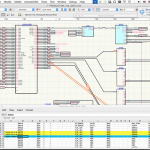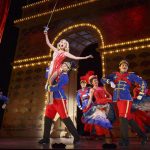The Addition of the Follow-Me System Makes Life Easier
As the story has been told through the years, Joe Elliott of Def Leppard played some shows in Japan some 15 years ago. A Japanese LD from Big One Lighting named Kenji Ohashi was hired to run the lighting for these shows. The artist liked what he was doing and decided to keep him on permanently.
There were only a couple of problems. First of all, Kenji is still employed permanently at Big One, in Japan, (They allow him to continue lighting Def Leppard and keep his home job). The other was that Kenji doesn’t speak English.
This meant that calling spotlight cues, for the band outside of Japan was not an option. For years, he had a list of cues and someone on the lighting crew would call the show for him. It cost production some extra cash, but they were loyal to their lighting designer. This led to another problem. The techs calling spots couldn’t speak a lick of Japanese. If something spontaneous happened on stage, Kenji could adjust his stage look, but he was dependent on someone else to read his mind while calling the spotlights. The struggle was real.

The First Step — Enter the Argentinian
Phay Mac Mahon has been out with the band as production manager for quite a while now. He had a successful career as a lighting designer for years before taking on the fulltime gig as production manager. He was familiar with the problems that Kenji faced every time they went to a new continent and had to source a spotlight caller and, if he was lucky, translator. Come four years ago Phay got a social call from a lighting guy named Ignacio Rosenberg, an LD as well as a popular tech. They went out for drinks in Los Angeles to catch up.
Iggy first came to the U.S. in 2004. After attending school, he worked on cruise ships for a while before catching a job with Upstaging as a lighting tech and board operator for years. Through years of touring he built up a network of friends and kept traveling. Being fascinated with Japan, he decided to spend some time in the country back around 2009-2010. He learned enough Japanese to understand it and speak a few words, but not a great deal. But it sparked an idea in Phay’s mind. What if he had a guy who could travel with the tour, call spots and actually talk with the LD? By now, it was obvious that Kenji had a forever job, but wouldn’t it be grand if he had someone he could converse with and become friends. Phay asked the younger man, ‘Can you call spots? Can you program a lighting console?’ He answered yes. The next thing you know, Iggy is on a plane to Lithuania, where he met Kenji and greeted him with a line spoken in Japanese. For a few years, Iggy would call spots, look after lighting opening acts and work with his friend.

Technological Advances Follow
This spring finds the band out on another arena run. They are using Kenji’s lighting design from last year, but they have added some new technology with the addition of a spotlight truss located 10 feet downstage of the center stage thrust. This truss contains eight Robe BMFL profile movers and one camera — for the Follow-Me system. Iggy controls the functions of the BMFLs through a grandMA2 Light console that is networked in with Kenji’s at FOH. Backstage are four operators, each behind a monitor with a 3D mouse. Through the camera on the spot truss, they can follow their designated performers. The singer has two light fixtures assigned to him while the other three roaming members each get one light. The drummer has a light as well, but it is locked in place for most of the show. At the end of the evening, Iggy’s 3D mouse follows him around the stage for bows. They employ the other two BMFL’s as active spares, just in case a lamp blows.
“The decision to go in another direction with spotlights was really borne out of necessity.” explains Iggy. “The fact is that almost every arena has some crap spots. While I speak English well, I have an accent. Sometimes people have a problem with that. It was time to move on from boomerang color systems with bad dimmers and no output/angle consistency.”
There were a few different automated spotlight systems released last year, each one has its perks and differences. With the Follow-Me system the operator can assign multiple fixtures to follow one person in real time. They can have two lights from the front and two from the rear follow a performer. This type of software is not new, as LDs have used a mouse to follow performers with a light for 20-plus years. But what has made it spectacular is the way it can map the light to a stage in 3D.

Iggy explains. “With this production, I have a basic 60-by-40-foot stage. But we have a thrust that extends out front as well as a drum riser that raises up above the band. The system needs to take all of that into consideration during the setup stage. I have nine stage positions. It’s a drag and drop target system; you no longer need to focus the spots on the positions, it’s all computer based, for calibration purposes. Three symmetrical spots across the downstage, three across the mid and three upstage. But here’s the deal — I put the downstage center one on the edge of the thrust, while the others are upstage along the apron. With the upstage row, I focus the center one right at the top of the drum kit. The computer then figures out all the math, and it works on this 3D plane.”
Follow-Me is a cost-effective Art-Net based calibration software package that utilizes any moving lights as follow-spots. Designed by a couple of clever lighting guys in Holland, they have eliminated the need for truss spots with some software. The grandMA console speaks Art-Net to the rack backstage, which sends a signal to the lights. The camera and spot op mice feed into the rack as well. Not only can Follow-Me be used to follow one or more performers with multiple moving heads but individual fixture selection offers the additional functionality of preset positioning for solos and surprise performances. Add in the fact that all the color bumps, beam sizes and fade outs will be perfectly executed by the console operator, Follow-Me is a great tool for any concert, TV or theatrical application.
For more on Follow-Me, go to www.follow-me.nu.

